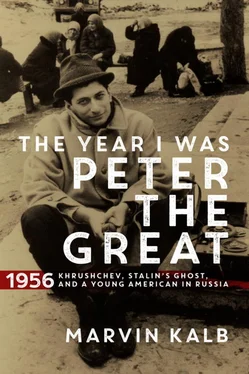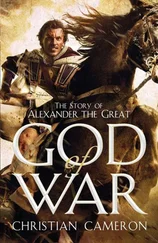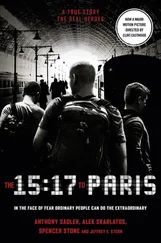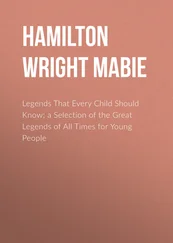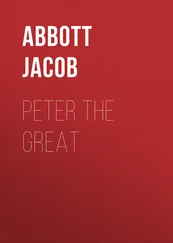All of this took place behind closed doors, but rumors quickly sprouted all over Moscow, like weeds in spring. Once a Komsomol leader in Kazan had been briefed on the secret speech, it was only a matter of time before a cabdriver in Leningrad would pick up the theme of Khrushchev’s stunning denunciation of Stalin, once the saint, now a killer. The Polish communist leader Boleslav Beirut, who had just been briefed and who routinely would inform the editor of the Polish communist newspaper about all major developments, told the editor about the midnight briefing. Naturally, over drinks, the editor would then share the news with reporters from other Polish newspapers, and they in turn with their Western colleagues. In communist times secrets were sacred, and most were kept, but this was one that the Kremlin leadership clearly wanted leaked to the public. This was hot news, and hot news traveled through the Soviet empire by rumor, by whisper, by sensible deduction, and, on occasion, by official proclamation.
At the U.S. embassy we could feel the political ground trembling beneath us, and, in the embassy courtyard, where we thought we were safe from Soviet electronic eavesdropping, we would swap stories and impressions. Khrushchev was now the boss, clearly, towering over Stalin’s corpse, but what next? In Moscow’s rarefied social circles, at dinner parties and receptions, we would share gossip, rumor, and occasionally facts. At the theater we might by chance bump into a Soviet official we had met elsewhere, and in a brief conversation pick up a phrase, a look, a reference to a Pravda article. At the JPRS, where I spent most of my time, I had the added benefit of being able to listen to Anna Holdcroft, a genuine expert on reading Soviet tea leaves and, it seemed to me, Khrushchev’s mind. She was a remarkable resource, and on more than a number of occasions her insights would end up in my Moscow diary, but never with her name attached to them. I decided, shortly after starting my diary, that I would not include names, conversations, or incidents that might be harmful to American interests or to innocent Russians. I kept my diary, which was not classified, in my room at American House, where I imagine anyone could have read it.
By March 19, a day after stories appeared for the first time in Western newspapers about a secret speech, I noted in my diary that the Central Committee of the Communist Party of the Soviet Union, led by Khrushchev, had “launched dramatic charges against the memory and legacy of Joseph Stalin.” I cited no specific source, but mentioned four of the charges.
“Stalin is said to have ‘murdered’ three-quarters of the membership of the 1934 Congress of the Communist Party.”
“He is said to have brutally slaughtered nine-tenths of the Red Army officer corps in the great purges of the 1930’s and thereby seriously affected the morale of the military just prior to the outbreak of World War II.”
“He is accused of ignoring intelligence reports from Germany and warnings from Churchill that Hitler was going to attack Russia in 1941.”
“He is accused of having concocted the ‘doctors’ plot’ as a perverted excuse for initiating a new bloodbath of the Communist Party leadership.”
Then, in summation, I used the phrase “it is believed,” suggesting I had gotten the information on “deep background” from a senior diplomatic source, more than likely Ambassador Bohlen, who by this time had learned definitively, from Israelis based in Warsaw, that Khrushchev had indeed delivered the rumored secret speech. “Deep background” meant I could use the information without attribution to any named source. I adhered rather rigidly to the rules of deep background while I worked as a translator at the JPRS and later, for many years, as a journalist. But now, more than sixty years later, I’m breaking the rules and taking the liberty of citing Bohlen. “It is believed that at some time during the 20th Party Congress,” I wrote, citing no source, “Khrushchev launched a vicious attack against Stalin as a man. He is believed to have called Stalin a madman, driven by a persecution mania. Further reports indicate that throughout the Soviet Union, these charges are now being discussed.”
Nine days later, on March 28, using a kind of coded language, Pravda went public with Khrushchev’s dethroning of Stalin. Deep background was no longer needed to protect a source. In a long article, spread across the bottom halves of the second and third pages of the four-page newspaper, Khrushchev buried the Stalin era, even though photos, paintings, and busts of the disgraced Soviet leader were still in evidence throughout the city. Not enough time had passed to remove them. Pravda drew an interesting distinction between Stalin in his early years of power and in his later years. In his early years Stalin actually made “creative” contributions to Marxism-Leninism, the newspaper noted, but “with the passage of time, this personality cult assumed more and more ugly forms and seriously damaged the cause.” My impression was that now that Pravda had spoken, Stalin’s image would soon follow Stalin’s crimes into the dustbin of Soviet history.
Everywhere, as it happened, except in the Soviet Republic of Georgia, Stalin’s birthplace. We were hearing from different sources in the diplomatic community that there, pro-Stalin demonstrations erupted throughout the country when word of Khrushchev’s speech reached Tbilisi. Not only were photos and paintings of Stalin not being removed; new ones were being plastered on trolleys and buses or hung in museums. As many as 60,000 Georgians carried flowers to the Stalin monument in Tbilisi. They shouted “Down with Khrushchev” and “Glory to the Great Stalin.” When they marched on government buildings, tanks and troops interceded. Clashes followed. More than twenty demonstrators were killed, sixty wounded, and many others arrested and imprisoned. I noted in my diary, “The Georgians are not interested in seeing Stalin, one of theirs, blasphemed, perhaps because in his downfall they see a new attack upon Georgians in general.”
I stopped one afternoon at the impressive Tretyakov Gallery, where a famous painting of Stalin and Kliment Voroshilov standing together on the Lenin Hills overlooking Moscow had been hanging for many years. Now it was gone. Muscovites ambled past the empty wall space as if the painting had never been there.
Snow was falling and the traffic was heavy, but I rushed over to the nearby Lenin Museum to check on whether paintings of Stalin were still hanging there. Until recently this architectural monstrosity had featured paintings of the young Stalin being tutored by an older, wiser Lenin—the ardent and ambitious revolutionary joined at the hip to the brilliant, visionary, inspiring leader of global communism. Many of the paintings were still there but the talkative docent, while discussing the paintings, never mentioned Stalin’s name, not once. It was as if you were still able to look at Stalin and yet not see him. I assumed that the paintings showing Stalin would soon be replaced by less offensive paintings showing only Lenin. As I started to leave the Lenin Museum I happened to pass a sign that read “ Zal 21 ,” “Room 21,” hanging at an odd angle on the door. Just at that moment a heavyset man carrying a tool kit opened the door. I glanced in and saw two huge paintings of Stalin being removed from a wall. “Black magic, Soviet style,” I thought—Khrushchev’s way of rewriting Soviet history.
For the next few wintry months, a time in Moscow of short days and long nights, snow and ice, and only occasionally a teasing flash of sunlight, I met many young Russians who were feeling the first flush of freedom caused by the thaw. They were experimenting with a new notion of free speech, sort of—what to say, how much to say, and when to say it. At the same time I was also fighting a nonstop war with the stuffy bureaucrats guarding access to Uvarov’s papers at libraries and archives. On reflection, I think I had better luck with the young Russians than I had with the library bureaucrats.
Читать дальше
